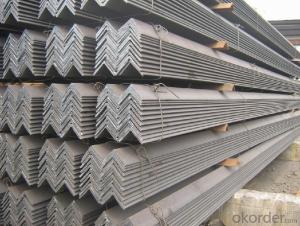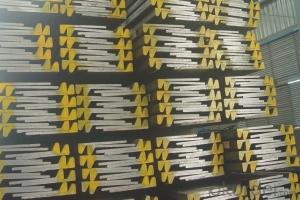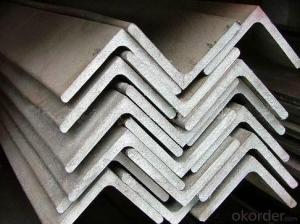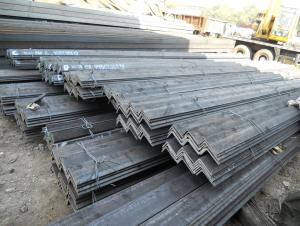Angle steel hot rolled high qulity ASTM A36 GB Q235B
- Loading Port:
- Tianjin
- Payment Terms:
- TT OR LC
- Min Order Qty:
- 50 m.t.
- Supply Capability:
- 200000 m.t./month
OKorder Service Pledge
OKorder Financial Service
You Might Also Like
Angle Steel Details:
| Minimum Order Quantity: | 25mtons | Unit: | m.t. | Loading Port: | China Main Port |
| Supply Ability: | 80000-100000MTS/YEAR | Payment Terms: | TT or LC |
Product Description:
Specifications of Angle Steel
1. Invoicing on theoretical weight or actual weight as customer request
2. Length: 6m, 9m, 12m as following table
3. Sizes

Sizes: 25mm-250mm | ||
a*t | ||
25*2.5-4.0 | 70*6.0-9.0 | 130*9.0-15 |
30*2.5-6.6 | 75*6.0-9.0 | 140*10-14 |
36*3.0-5.0 | 80*5.0-10 | 150*10-20 |
38*2.3-6.0 | 90*7.0-10 | 160*10-16 |
40*3.0-5.0 | 100*6.0-12 | 175*12-15 |
45*4.0-6.0 | 110*8.0-10 | 180*12-18 |
50*4.0-6.0 | 120*6.0-15 | 200*14-25 |
60*4.0-8.0 | 125*8.0-14 | 250*25 |
5. Payment terms:
1).100% irrevocable L/C at sight.
2).30% T/T prepaid and the balance against the copy of B/L.
3).30% T/T prepaid and the balance against L/C
6.Material details:
Alloy No | Grade | Element (%) | |||||
C | Mn | S | P | Si | |||
|
|
|
|
|
|
| |
Q235 | B | 0.12—0.20 | 0.3—0.7 | ≤0.045 | ≤0.045 | ≤0.3 | |
|
|
|
|
|
|
| |
Alloy No | Grade | Yielding strength point( Mpa) | |||||
Thickness (mm) | |||||||
≤16 | >16--40 | >40--60 | >60--100 | ||||
≥ | |||||||
|
|
|
|
|
| ||
Q235 | B | 235 | 225 | 215 | 205 | ||
Alloy No | Grade | Tensile strength (Mpa) | Elongation after fracture (%) | ||||
Thickness (mm) | |||||||
| ≤16 | >16--40 | >40--60 | >60--100 | |||
≥ | |||||||
|
|
|
|
|
|
| |
Q235 | B | 375--500 | 26 | 25 | 24 | 23 | |
Usage & Applications of Angle Steel
According to the needs of different structures, Angle can compose to different force support component, and also can be the connections between components. It is widely used in various building structures and engineering structures such as roof beams, bridges, transmission towers, hoisting machinery and transport machinery, ships, industrial furnaces, reaction tower, container frame and warehouse etc.
Packaging & Delivery of Angle Steel
1. Packing: it is nude packed in bundles by steel wire rod
2. Bundle weight: not more than 3.5MT for bulk vessel; less than 3 MT for container load
3. Marks:
Color marking: There will be color marking on both end of the bundle for the cargo delivered by bulk vessel. That makes it easily to distinguish at the destination port.
Tag mark: there will be tag mark tied up on the bundles. The information usually including supplier logo and name, product name, made in China, shipping marks and other information request by the customer.
If loading by container the marking is not needed, but we will prepare it as customer request.
Production flow of Angle Steel
Material prepare (billet) —heat up—rough rolling—precision rolling—cooling—packing—storage and transportation
- Q:Can steel angles be used in the construction of industrial chimneys?
- Yes, steel angles can be used in the construction of industrial chimneys. Steel angles provide structural support and stability to the chimney, making them a common choice in industrial construction projects.
- Q:Are steel angles susceptible to fatigue failure?
- Indeed, steel angles can experience fatigue failure. This failure occurs when a material undergoes repeated cycles of loading and unloading, resulting in the development and spread of cracks within the material. Similar to other structural components, steel angles can be exposed to cyclic loading conditions, such as vibrations, oscillations, or repeated stress applications. Multiple factors influence the occurrence of fatigue failure in steel angles, including the properties of the material, the geometric shape of the angle, the magnitude and frequency of the applied loads, and the presence of any defects or stress concentrations. Notches, welds, or sharp corners can particularly act as stress raisers, leading to localized stress concentrations and potential sites for crack initiation. To mitigate the risk of fatigue failure, engineers and designers consider various strategies. Firstly, they thoroughly assess the anticipated loading conditions and incorporate appropriate safety factors into the design to ensure that the steel angles do not experience stress levels surpassing their fatigue strength. Secondly, they strive to minimize stress concentrations through proper design techniques, such as incorporating rounded corners or fillets, which help distribute stress more uniformly and decrease the likelihood of crack initiation. Additionally, regular inspection and maintenance of structures play a crucial role in identifying potential fatigue cracks, enabling necessary repairs or replacements.
- Q:What are the different surface finishes available for galvanized steel angles?
- There are several different surface finishes available for galvanized steel angles. 1. Smooth: This is the most common surface finish for galvanized steel angles. It provides a smooth and polished appearance, making it suitable for a wide range of applications. 2. Matte: Matte finish is achieved by applying a chemical treatment to the galvanized steel angles. This finish provides a non-reflective surface, making it ideal for applications where glare is a concern. 3. Textured: Textured finish involves adding a textured pattern to the surface of the galvanized steel angles. This can be done through embossing or by applying a textured coating. The textured surface enhances grip and provides a decorative element. 4. Powder coated: Galvanized steel angles can also be powder coated, which involves applying a dry powder to the surface and then curing it in a high-temperature oven. Powder coating offers a durable and attractive finish, with a wide range of color options available. 5. Painted: Another option is to paint the galvanized steel angles. This can be done using either oil-based or water-based paints. Painting adds an extra layer of protection against corrosion and can be customized to match specific color requirements. Overall, the choice of surface finish for galvanized steel angles depends on the intended use, aesthetic preferences, and the level of protection required against corrosion. It is important to consider the environmental conditions and the specific needs of the application when selecting a surface finish.
- Q:What are the different types of steel angles used in transmission line towers?
- There are several different types of steel angles that are commonly used in transmission line towers. These angles are specifically designed to provide structural support and stability to the towers, ensuring that they can withstand the weight of the transmission lines and the environmental conditions they are exposed to. 1. Equal leg angle: This type of angle has two legs of equal length, forming a right angle. It is a widely used angle in transmission line towers due to its simple design and ease of fabrication. 2. Unequal leg angle: As the name suggests, this type of angle has two legs of unequal length, forming an acute or obtuse angle. Unequal leg angles are used in transmission line towers when there is a need for specific load-bearing requirements. 3. Bulb angle: Bulb angles have a unique shape with a bulbous end that provides additional strength and stability. This type of angle is often used in critical areas of transmission line towers that require extra support, such as at the base or at connection points. 4. Lipped angle: Lipped angles have an extended lip on one side, which increases their load-bearing capacity. This type of angle is commonly used in transmission line towers where there is a need for increased strength and stability. 5. Back-to-back angle: Back-to-back angles are two equal leg angles joined back-to-back with their flanges touching. This configuration creates a wider angle that offers enhanced load-bearing capabilities and resistance to bending. It is often used in transmission line towers where higher loads or longer spans need to be supported. Each type of steel angle used in transmission line towers has its own unique characteristics and advantages, allowing engineers to select the most appropriate angle for the specific requirements of the tower design. These angles are carefully chosen to ensure the overall strength, stability, and durability of the transmission line tower, ultimately contributing to the reliable and efficient transmission of electricity.
- Q:Can steel angles be used for sign posts?
- Certainly! Sign posts can indeed utilize steel angles. Due to their robustness and endurance, steel angles are frequently employed in construction. They can effectively offer the required support and stability for sign posts, particularly in regions prone to strong winds or heavy traffic. Moreover, the versatility of steel angles shines through as they can be effortlessly welded or bolted together, presenting an adaptable choice for sign post installation. Furthermore, their immunity to corrosion guarantees a lengthier lifespan, thereby diminishing expenses associated with maintenance and replacement.
- Q:What are the different types of steel angles used in engineering?
- In engineering, there are several different types of steel angles that are commonly used. These angles are typically made from hot-rolled steel and are available in various sizes and dimensions to suit different applications. Some of the different types of steel angles used in engineering include: 1. Equal angles: These angles have equal sides and are commonly used for structural purposes, such as supporting beams or columns. They provide stability and strength to the structure and are often used in construction projects. 2. Unequal angles: As the name suggests, unequal angles have different length sides. These angles are often used in applications where one side needs to be longer or shorter than the other, such as bracing or framing. 3. L-shaped angles: L-shaped angles have one side longer than the other, forming an L-shape. These angles are commonly used in construction to provide support and reinforcement, such as for corners, joints, or connections. 4. Structural angles: Structural angles are specifically designed to bear heavy loads and provide structural stability. They are commonly used in building frame structures, bridges, or other load-bearing applications. 5. Stainless steel angles: Stainless steel angles are made from stainless steel, which offers excellent corrosion resistance and durability. These angles are often used in environments where rust or corrosion may be a concern, such as marine applications or food processing facilities. 6. Galvanized steel angles: Galvanized steel angles are coated with a layer of zinc to provide corrosion resistance. These angles are commonly used in outdoor applications or environments where exposure to moisture or harsh conditions is expected. 7. Perforated steel angles: Perforated steel angles have holes or perforations along their length, allowing for improved ventilation or drainage. These angles are often used in applications where airflow or water drainage is required, such as in HVAC systems or outdoor structures. Overall, the choice of steel angle depends on the specific requirements of the engineering project. Factors such as load-bearing capacity, resistance to corrosion, and aesthetic considerations play a crucial role in selecting the appropriate type of steel angle for a particular application.
- Q:Can steel angles be used as supports for HVAC systems or ductwork?
- Yes, steel angles can be used as supports for HVAC systems or ductwork. Steel angles are commonly used in construction and engineering projects due to their strength and durability. They can provide a stable and secure support structure for HVAC systems or ductwork, ensuring that they are properly installed and can withstand the weight and vibrations associated with their operation. Steel angles can be easily fabricated and installed, making them a cost-effective and efficient solution for supporting HVAC systems or ductwork.
- Q:Can steel angles be used as reinforcements in masonry walls?
- Yes, steel angles can be used as reinforcements in masonry walls. Steel angles are commonly used to provide additional strength and stability to masonry structures. They are often embedded within the mortar joints or anchored into the masonry units to enhance the overall structural integrity of the wall. The steel angles help to distribute and resist the forces acting on the wall, such as lateral loads or bending moments, making them a reliable choice for reinforcement in masonry construction.
- Q:What are the different methods for strengthening steel angles?
- There are several methods for strengthening steel angles, depending on the specific requirements and intended applications. Here are some of the common methods: 1. Heat treatment: One of the most common methods for strengthening steel angles is through heat treatment processes such as quenching and tempering. Quenching involves rapidly cooling the steel angle after heating it to a high temperature, which increases its hardness and strength. Tempering, on the other hand, involves reheating the quenched steel angle to a lower temperature, which reduces its brittleness and improves its toughness. 2. Alloying: By adding certain alloying elements such as chromium, molybdenum, or nickel, the strength and hardness of steel angles can be significantly increased. These alloying elements form solid solutions with the iron matrix, resulting in improved mechanical properties and resistance to wear or corrosion. 3. Cold working: Cold working processes like cold rolling, cold drawing, or cold forming can enhance the strength and hardness of steel angles. These processes involve deforming the steel angle at room temperature, which causes dislocations in the crystal structure and increases its strength. 4. Welding: Welding techniques such as fusion welding or spot welding can be utilized to strengthen steel angles by joining them with other steel components. The weld joint can often provide additional strength and rigidity to the steel angle structure. 5. Surface treatments: Applying various surface treatments like galvanizing, powder coating, or painting can improve the corrosion resistance of steel angles, thereby increasing their longevity and overall strength. It is important to note that the choice of method for strengthening steel angles depends on factors such as the specific grade of steel, intended application, and desired mechanical properties. Consulting with a professional engineer or metallurgist is recommended to determine the most suitable method for a particular scenario.
- Q:Can steel angles be used for mezzanine floors?
- Yes, steel angles can be used for mezzanine floors. Steel angles are commonly used as structural components in construction, including for mezzanine floors. They provide stability and support to the structure, allowing for the creation of additional floor space. Steel angles are strong and durable, making them suitable for supporting heavy loads and ensuring the safety of the mezzanine floor. Additionally, steel angles can be easily fabricated and installed, making them a cost-effective choice for constructing mezzanine floors.
1. Manufacturer Overview |
|
|---|---|
| Location | |
| Year Established | |
| Annual Output Value | |
| Main Markets | |
| Company Certifications | |
2. Manufacturer Certificates |
|
|---|---|
| a) Certification Name | |
| Range | |
| Reference | |
| Validity Period | |
3. Manufacturer Capability |
|
|---|---|
| a)Trade Capacity | |
| Nearest Port | |
| Export Percentage | |
| No.of Employees in Trade Department | |
| Language Spoken: | |
| b)Factory Information | |
| Factory Size: | |
| No. of Production Lines | |
| Contract Manufacturing | |
| Product Price Range | |
Send your message to us
Angle steel hot rolled high qulity ASTM A36 GB Q235B
- Loading Port:
- Tianjin
- Payment Terms:
- TT OR LC
- Min Order Qty:
- 50 m.t.
- Supply Capability:
- 200000 m.t./month
OKorder Service Pledge
OKorder Financial Service
Similar products
New products
Hot products
Hot Searches
Related keywords






























